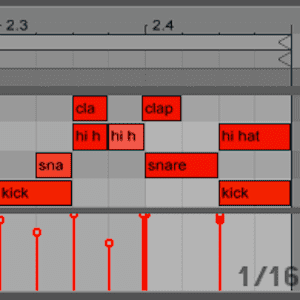Our step-by-step drum programming walkthrough focuses on a gritty indie-dance beat with attitude.
Beat Dissected is a regular series which deconstructs drum patterns, showing you how to program them in any DAW. Just copy the grids in your own software to recreate the loop.
Here’s the complete beat we’ll be making this time:
To download the samples for this beat, click here. The samples are provided on a completely royalty-free basis. They may not be sold or given away, either in whole or in part.
You must register for a free Attack account and sign up to receive our newsletter in order to download the samples. New members can register here. Existing members can log in here.
Spec
Tempo
125-127bpm
Swing
60-65%
Sounds
mainly vintage drum machine samples
Step 1
For the kick drum in this beat we’ve layered a tight, snappy kick sample (try something like a TR-707 or CR-78 as a starting point) with an 808 for an added bit of low-end clout. When layering, remember to tweak the relative tuning of each (and beware any phase issues) so that the two combine to give a result more than the sum of its parts. We’ve kept processing to a minimum, with just a transient shaper to emphasise the click at the front of the sound.
The relatively complex kick pattern includes two lower velocity hits in the first bar to make the groove more interesting. For added variation, you could also try using a different sample for these two hits, or subtly tweaking the envelope or filter settings of the main kick sample.
Step 2
This beat is all about the interplay between the kick and snare, with the snare ‘filling the gaps’ left by the kick. The snare sound here is based on a sample taken from the Roland TR-707 – it’s a snappy, chunky sound with plenty of mid-range tone that works nicely with the kick. Live snare sounds can also sound great in beats like this.
Step 3
The hi-hat sits in the offbeat and pulls the groove together. The doubled-up hits mid-way through each bar also use a velocity variation to add a bit of dynamic movement to the pattern.
Audition a few different hats for this part – although machine-derived samples often fit the mix, an organic sample of a real hi-hat may work better for some tracks.
Step 4
The final touch is a handclap on the fourth beat of each bar, which can be doubled up to add a turnaround variation or just to make the beat more complex. You can choose either to keep the clap fairly dry or be liberal with a long hall reverb. Or anything in between.
Note that the clap is triggered just before the snare, giving the beat a more urgent, rushed feel. Sliding the hit further back will create a lazier, more relaxed beat. Alternatively, experiment with timing and velocity variations throughout the entire track to give the beat a more human, live feel.





02.08 PM
hi, i really love the Beat dissected section. I have a question, what do you mean with a swing of 60-65% and how can i use it on ableton live??
Thanks!
08.25 AM
Swing is the amount the notes/hits will move from their original position when played. When the beat is fully quantised it will sound rigid, implementing swing will make it looser, funkier and basically make you want to move to the groove more. Here’s a video that should help…
http://m.youtube.com/#/watch?v=zcDaWRXlvIE&desktop_uri=%2Fwatch%3Fv%3DzcDaWRXlvIE